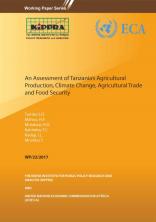WP22 Scoping paper Tanzania

In Tanzania, agriculture is predominantly characterized as a smallholder business, with farm sizes ranging from 1 to 3 hectares (ha), dedicated to subsistence with limited marketable surpluses. Smallholders have been responsible for more than 80 per cent of Tanzania’s agricultural exports dominated by traditional exports, including cofee, tea, cashew nuts, tobacco and sisal. Agriculture accounts for 30 per cent of total exports. The contribution of agriculture to GDP has declined over the decade from about a half in the 1990s to around a quarter most recently. The declining GDP share of agriculture is due to the increasing importance of the mineral sector. Further, the agricultural sector is characterized by traditional farming methods with low levels of technology adoption, low utilization of modern inputs and ineicient resource allocation (Mashindano and Kaino, 2009). It has poor linkages to other domestic sectors, with a poorly developed marketing system, and under-developed infrastructure that afects access to both domestic and international markets.
The agricultural sector is the main contributor to food security and is the primary source of livelihood for more than 80 per cent of the population (United Republic of Tanzania-URT, 2012). However, agriculture is characterized by high production risks due to its dependence on unpredictable and highly variable weather, and low returns on investment. Due to the country’s dependence on agriculture, all strategies for sustainable development have identiied agriculture and food security as critical pillars for poverty alleviation. The food crops subsector accounts
for about 65 per cent of agricultural GDP, while cash crops account for about 10 per cent; about a quarter of the remaining percentage is accounted for by the livestock sub-sector (URT, 2006). Within food crops, maize is the most important accounting for over 20 per cent of total agricultural GDP followed by rice, beans, cassava, sorghum, and wheat (URT, 2006c).